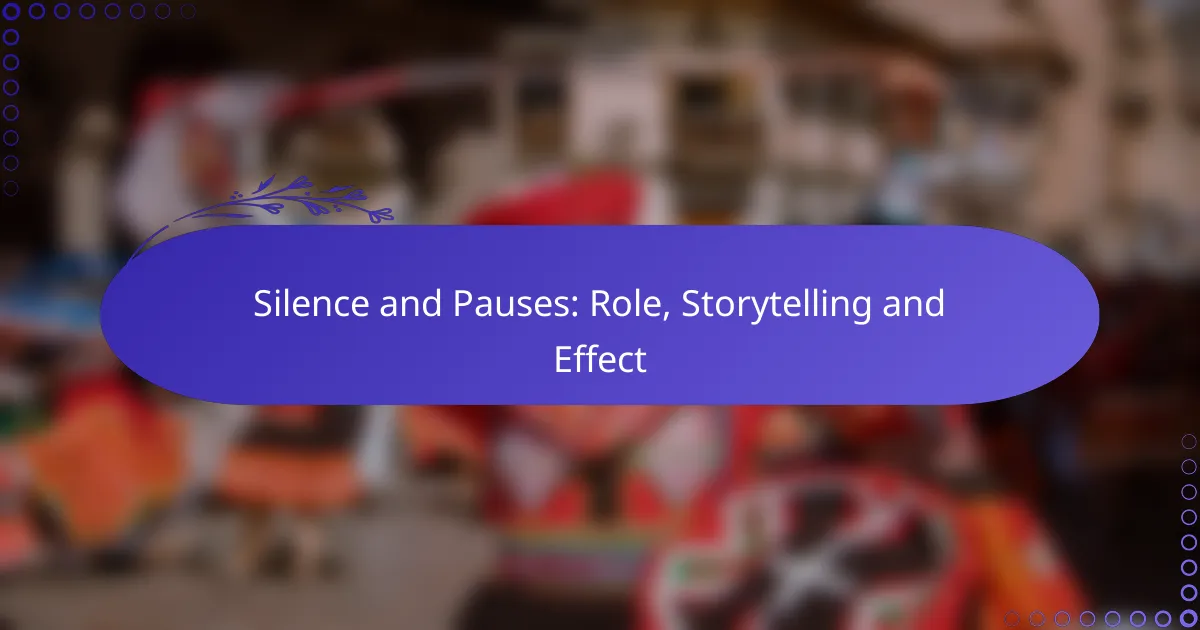Silence and pauses are essential tools in storytelling, serving to amplify emotional resonance and enhance audience engagement. By strategically incorporating these elements, storytellers can create tension, emphasize key themes, and provide moments for reflection, ultimately making the narrative more impactful and memorable.
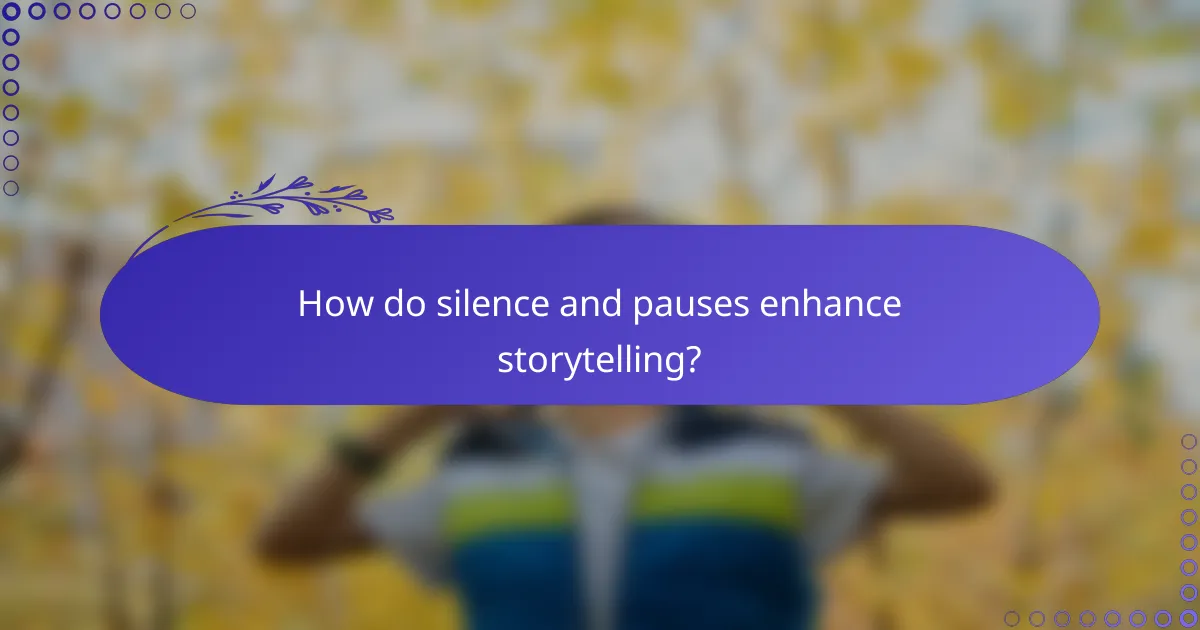
How do silence and pauses enhance storytelling?
Silence and pauses play a crucial role in storytelling by creating space for emotional impact and allowing the audience to absorb information. These elements can heighten tension, underscore important messages, and prompt deeper contemplation, making the narrative more engaging and memorable.
Creates dramatic tension
Silence can build suspense and anticipation in storytelling, making the audience more invested in the unfolding events. For instance, a sudden pause before a pivotal moment can amplify the emotional stakes, leaving viewers on the edge of their seats.
To effectively use silence for dramatic tension, consider the timing and context. A well-placed pause can signal a shift in the narrative or highlight a character’s internal struggle. Aim for brief silences, lasting only a few seconds, to maintain engagement without losing momentum.
Emphasizes key points
Pauses can serve as powerful tools to emphasize essential messages within a story. By creating a moment of silence before or after a significant statement, storytellers can draw attention to that particular idea, ensuring it resonates with the audience.
When incorporating pauses for emphasis, be mindful of their placement. A pause lasting one to two seconds can effectively highlight a key point without disrupting the flow of the narrative. Use this technique sparingly to avoid diminishing its impact.
Encourages audience reflection
Silence invites the audience to reflect on the story’s themes and characters, fostering a deeper connection to the narrative. By allowing moments of quiet, storytellers create opportunities for viewers to process emotions and consider the implications of the story.
To encourage reflection, integrate pauses at strategic moments, such as after a character’s revelation or a critical plot twist. These brief interludes can last from a couple of seconds to several moments, depending on the emotional weight of the scene, giving the audience time to engage with the material thoughtfully.
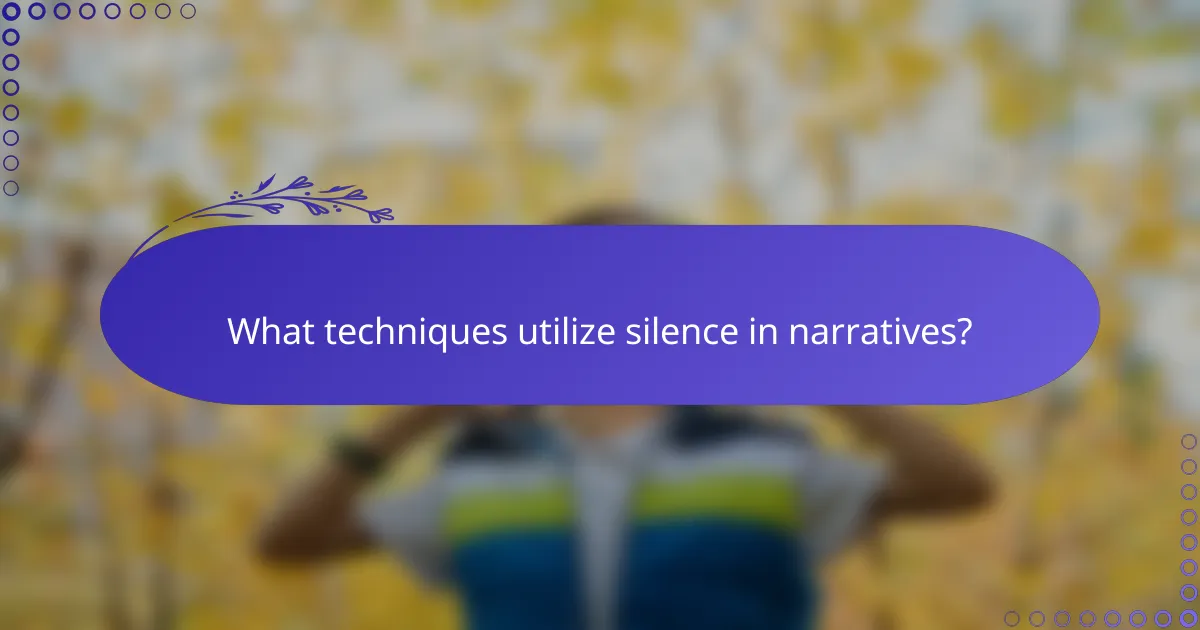
What techniques utilize silence in narratives?
Silence in narratives can enhance storytelling by creating tension, emphasizing emotions, or allowing the audience to reflect. Techniques such as strategic pauses in dialogue and silence in visual storytelling are effective ways to utilize this powerful tool.
Strategic pauses in dialogue
Strategic pauses in dialogue can heighten drama and allow characters to process emotions. For instance, a character might pause before revealing a secret, creating suspense and engaging the audience’s curiosity. These pauses should be timed carefully, typically lasting a few seconds, to maintain the flow of conversation while amplifying the impact.
When using pauses, consider the emotional weight of the moment. A longer pause may be appropriate for a heavy revelation, while shorter pauses can add rhythm and tension in lighter exchanges. Avoid overusing pauses, as they can disrupt pacing and lead to audience disengagement.
Silence in visual storytelling
Silence in visual storytelling often manifests through still images or scenes devoid of dialogue, allowing viewers to interpret emotions and themes independently. For example, a long shot of a character alone in a vast landscape can evoke feelings of isolation without any spoken words. This technique encourages deeper engagement and personal reflection from the audience.
To effectively use silence visually, focus on composition, lighting, and body language. A well-framed shot can communicate more than words, so ensure that visual elements align with the intended emotional tone. Avoid cluttered scenes that may distract from the silence’s impact, as simplicity often enhances the message conveyed through absence.
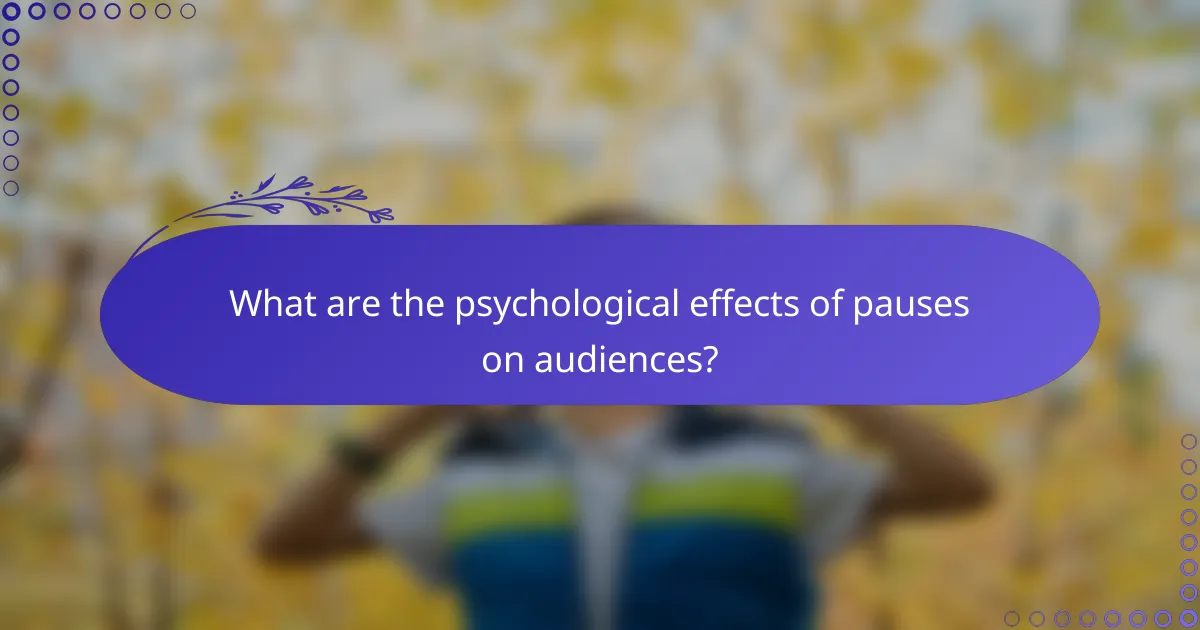
What are the psychological effects of pauses on audiences?
Pauses in storytelling can significantly influence audience perception and engagement. They create moments for reflection, allowing listeners to process information and heighten emotional responses.
Increases engagement
Pauses can effectively capture and maintain audience attention. By introducing silence, speakers can create suspense or emphasize key points, prompting listeners to become more invested in the narrative.
For instance, a well-timed pause before revealing a crucial plot twist can heighten anticipation, making the audience more eager to hear what comes next. This technique is often used in public speaking and presentations to keep the audience focused.
Enhances emotional impact
Silence can amplify the emotional weight of a story. When a speaker pauses after a poignant statement, it allows the audience to absorb the gravity of the moment, fostering a deeper emotional connection.
Consider a dramatic monologue where the speaker pauses after expressing a heartfelt sentiment. This brief silence can evoke feelings of empathy and reflection, making the audience more likely to resonate with the message. Using pauses strategically can transform a simple narrative into a powerful emotional experience.
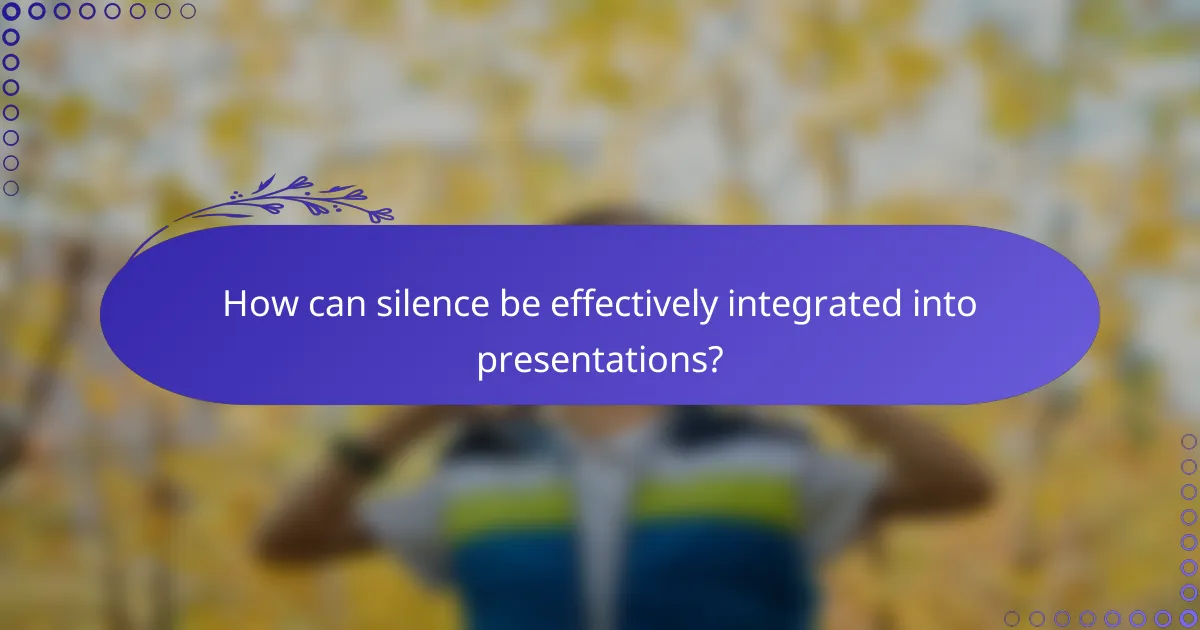
How can silence be effectively integrated into presentations?
Silence can enhance presentations by creating moments of reflection and emphasizing key points. Integrating pauses strategically allows the audience to absorb information and increases the impact of your message.
Timing and pacing strategies
Effective timing and pacing involve knowing when to incorporate silence for maximum effect. Aim for pauses after delivering important information or before transitioning to a new topic. A good rule of thumb is to pause for a few seconds—typically between two to five seconds—depending on the context and audience engagement.
Consider using silence to break up sections of your presentation. This not only helps maintain audience attention but also gives them time to process what has been said. Practice your pacing to find a natural rhythm that feels comfortable for you and your audience.
Using silence for emphasis
Silence can serve as a powerful tool for emphasis, drawing attention to critical points in your presentation. For instance, after stating a significant fact or conclusion, a brief pause can heighten its importance and allow the audience to reflect on its implications.
To effectively use silence for emphasis, be intentional about where you place your pauses. Avoid overusing silence, as it can lose its impact if used too frequently. Instead, reserve it for key moments that warrant extra attention, ensuring that your message resonates with your audience.

What role does cultural context play in the perception of silence?
Cultural context significantly influences how silence is perceived and interpreted. In some cultures, silence can convey respect or contemplation, while in others, it may indicate discomfort or a lack of engagement.
Varied interpretations across cultures
Different cultures assign various meanings to silence, affecting communication styles. For instance, in many East Asian cultures, silence is often viewed as a sign of thoughtfulness and respect, while in Western cultures, it may be interpreted as awkwardness or a lack of response.
Understanding these cultural nuances is crucial for effective communication. For example, a person from a culture that values silence may feel comfortable with pauses in conversation, whereas someone from a more talkative culture might perceive those pauses as a signal to fill the silence.
Silence in different storytelling traditions
Silence plays a vital role in storytelling across cultures, enhancing emotional depth and tension. In oral traditions, pauses can create suspense, allowing the audience to absorb the narrative and anticipate what comes next.
For example, in Japanese storytelling, the use of silence can evoke strong emotions and reflect the inner thoughts of characters. In contrast, Western storytelling often uses dialogue to drive the plot, with silence serving more as a dramatic pause than a narrative tool.
Writers and storytellers should consider how silence can be employed to enrich their narratives. Incorporating intentional pauses can help convey themes, build suspense, or emphasize key moments, making the story more engaging for the audience.
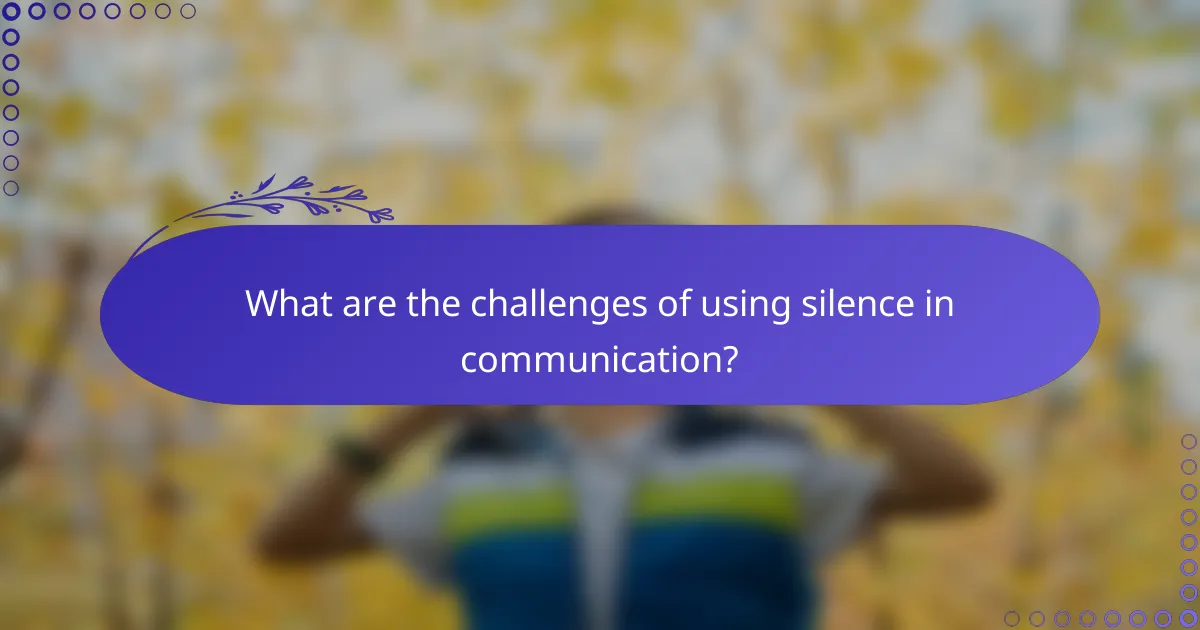
What are the challenges of using silence in communication?
Silence in communication can lead to various challenges, primarily due to its potential for misinterpretation and the difficulty in balancing it with verbal content. Understanding these challenges is crucial for effective interaction.
Misinterpretation risks
Silence can be easily misinterpreted, leading to confusion or misunderstandings. For instance, a pause during a conversation might be seen as a sign of disagreement or discomfort, rather than a moment for reflection.
To mitigate misinterpretation, it is essential to provide context for your silence. Clarifying your intentions beforehand can help ensure that your audience understands the purpose of the pause, whether it is for emphasis or contemplation.
Balancing silence with content
Finding the right balance between silence and spoken content is vital for effective communication. Too much silence can create awkwardness, while too little can overwhelm the listener.
A good rule of thumb is to use silence strategically, such as after delivering a key point to allow it to resonate. Practicing this balance can enhance engagement and ensure that your message is received as intended.

How does silence influence audience retention?
Silence plays a crucial role in enhancing audience retention by allowing listeners to process information more effectively. Pauses create a space for reflection, which can significantly improve how well the audience remembers the content presented.
Improves memory recall
Incorporating silence into storytelling can enhance memory recall by giving the audience time to absorb key points. Research suggests that brief pauses can increase retention rates by allowing listeners to mentally summarize what they have just heard. For instance, a pause after a significant statement can help solidify that information in the audience’s memory.
To maximize memory recall, consider using silence strategically after important messages. A good rule of thumb is to pause for a few seconds after each major point to let the information resonate.
Facilitates deeper understanding
Silence facilitates deeper understanding by encouraging listeners to reflect on the material. When speakers pause, it prompts the audience to think critically about the content, fostering engagement and comprehension. This is particularly effective in complex topics where additional thought is necessary to grasp the nuances.
To enhance understanding, use pauses before introducing new concepts or after asking rhetorical questions. This technique allows the audience to mentally prepare for the upcoming information, leading to a more profound grasp of the subject matter.

What emerging trends are shaping the use of silence in media?
Emerging trends in media increasingly highlight the strategic use of silence to enhance storytelling and emotional impact. Creators are recognizing that pauses can amplify tension, create suspense, and allow audiences to process information more deeply.
Increased use of silence in digital storytelling
Digital storytelling is seeing a rise in the intentional use of silence, particularly in video and audio formats. Creators are leveraging pauses to draw attention to key moments, allowing viewers to absorb the narrative’s emotional weight. This trend is evident in platforms like YouTube and podcasts, where silence can serve as a powerful tool for emphasis.
Silence as a tool for emotional engagement
Silence can significantly enhance emotional engagement by providing space for reflection. For instance, in film, a well-placed pause can heighten the impact of a dramatic scene, making the audience feel the weight of the moment. This technique encourages viewers to connect more personally with the story and its characters.
Cross-cultural variations in the use of silence
Cultural context plays a crucial role in how silence is perceived and utilized in media. In some cultures, silence is a sign of respect or contemplation, while in others, it may indicate discomfort or tension. Understanding these nuances is essential for creators aiming to resonate with diverse audiences, particularly in global media productions.
Technological advancements influencing silence
Advancements in technology are reshaping how silence is integrated into media. For example, sound design software allows creators to manipulate audio dynamics, making silence more pronounced and impactful. This capability enables filmmakers and audio producers to craft experiences that utilize silence effectively, enhancing storytelling through soundscapes.
